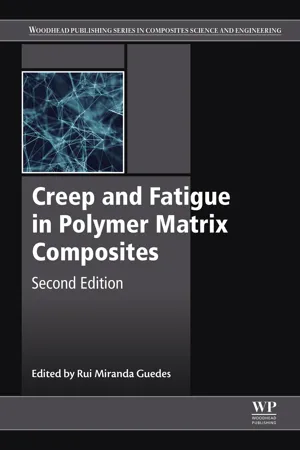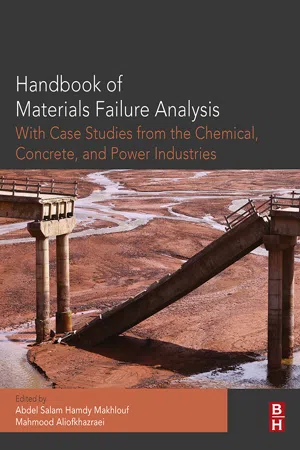Creep Rupture
Creep rupture refers to the failure of a material under constant stress at high temperatures over an extended period. It is a time-dependent phenomenon that occurs in materials such as metals and alloys, and is characterized by the gradual deformation and eventual fracture of the material. Creep rupture is a critical consideration in the design and operation of high-temperature components in engineering applications.
7 Key excerpts on "Creep Rupture"
- Arshad Ahmed, John Sturges(Authors)
- 2014(Publication Date)
- Routledge(Publisher)
...It is the sharpness of the crack tip that acts as a great stress intensifier. If we drill a hole through the crack tip as shown in Figure 19.13, the hole increases the radius of the crack tip by orders of magnitude to the point where the stress intensity is reduced so the crack no longer grows with each stress cycle. 19.6 Creep failure Creep is the term given to plastic deformation that occurs in materials subject to stress over very long time periods. It can occur at elevated temperatures in some metals, but it can also occur at ambient temperatures in other metals. Materials such as concrete, polymers and timber can also suffer creep at ambient temperatures, and these will be discussed later. Creep is generally an undesirable phenomenon and is often the limiting factor in the lifetime of components; it is usually a concern for engineers and metallurgists when evaluating the life of components that operate under high stresses and/or elevated temperatures. Creep is not necessarily a failure mode, but is often a damage mechanism. However, in some cases it can be the cause of failure, and such an example with concrete is discussed at the end of Chapter 20. Examples of creep failure for non-civil engineering applications include turbine blades in jet engines, boilers, nuclear power plant elements, incandescent light bulb filaments, etc. 19.6.1 Creep behaviour In a creep test, a constant load is applied to a tension specimen maintained at a constant temperature. Strain is then measured over a period of time. The slope of the strain vs time curve is the strain rate of the test during the steady state phase of the test. Put another way, the slope is the creep rate of the material. Figure 19.14 is a schematic representation of the typical creep behaviour of a metal. Primary creep, stage I, is a period of decreasing creep rate (D f /D t) and is transient creep; during this stage deformation takes place and the resistance to creep increases until stage II...
- eBook - ePub
Engineering Physics of High-Temperature Materials
Metals, Ice, Rocks, and Ceramics
- Nirmal K. Sinha, Shoma Sinha(Authors)
- 2022(Publication Date)
- Wiley(Publisher)
...6 Phenomenological Creep Failure Models CHAPTER MENU 6.1 Creep and Creep Failure 6.2 Steady-State Creep 6.3 Commonly Used Creep Experiments and Strength Tests 6.3.1 Constant Stress and Constant Deformation (CD) Rate Tests 6.3.2 A Short Glimpse of Creep Tests 6.3.3 Power Law for Creep 6.3.4 Larsen and Miller Concept 6.3.5 Monkman and Grant (M-G) Relationship 6.3.6 Rabotnov–Kachanov Concept for Creep Fracture 6.3.7 Breaking Tradition – θ -Projection Concept 6.4 Modeling Very Long-Term Creep Rupture from Short-Term Tests 6.4.1 Traditional Approaches for Power-Generation Operations 6.4.2 Captivating and Entrenched Focus on Minimum Creep Rate 6.5 High-Temperature Low-Cycle Fatigue (HT-LCF) and Dwell Fatigue 6.6 Crucial Tests on Rate Sensitivity of High-Temperature Strength 6.7 Rational Approach Inspired by the Principle of “Hindsight 20/20” References 6.1 Creep and Creep Failure High‐temperature engineering problems require solutions in terms of specific design stress, strain, and/or structural damage limits. Engineers must know the material characteristics or the interdependence between stress, strain, damage state, and time for a given component at a given temperature distribution and loading or deformation history. To improve the efficiency of high‐temperature equipment, such as that in power‐generating systems and jet engines, the requirement is to increase the operating temperature. As the operating temperatures are increased, environmental issues affecting the structural components start playing important roles. An engineering structure or component can be designed to function properly and achieve the required life under specified operating conditions without failure if the creep, creep damage, and fracture characteristics of a material are known. Creep and fracture of natural or manufactured metals and alloys is part of a larger field of study, such as the deformation and failure of all polycrystalline solids...
- eBook - ePub
Additive and Traditionally Manufactured Components
A Comparative Analysis of Mechanical Properties
- Joshua Pelleg(Author)
- 2020(Publication Date)
- Elsevier(Publisher)
...The rate of deformation is a function of exposure time, temperature, and applied load and depends on material properties. Creep is the tendency of a solid material to move slowly under the influence of mechanical stress but still below the yield strength and deform permanently. Creep is more severe in materials that are subjected to heat for long periods and generally increase as their temperature increase until a critical failure (dimensional and shape changes, which makes a component useless) is reached near the melting point. Therefore, creep is of concern to engineers when designing components to operate under high stress or high temperatures. However, creep may occur at relatively moderate temperatures in many cases. Even some ceramics with low-temperature ductility may creep ~ 0.5 T m. An important consideration is the choice of the type of material, namely, single or polycrystalline material. In order to eliminate grain boundary sliding in the material while exposed to some elevated temperature single crystal is the obvious choice. However, for many reasons such as other mechanical properties or cost factor consideration, polycrystalline materials are used despite their limitations for high-temperature applications. Grain size is a factor. A compromise must be made between small grain size, which enhances most of the mechanical properties, and large grained material, which is preferred for long-time exposure (creep) at high temperature. Ti6Al4V alloy also known as Ti64 is the most commonly used titanium alloy. It exhibits good mechanical and physical properties and due to its lightweight it is used in aerospace applications. These unique properties are strongly affected by chemical composition, microstructure, deformation, and heat-treatment history. The most commonly used titanium alloy is the two-phase (α + β) alloy. Significant research was devoted to improving the microstructure and attaining appropriate mechanical properties...
- eBook - ePub
- Fujio Abe, Torsten-Ulf Kern, R Viswanathan(Authors)
- 2008(Publication Date)
- Woodhead Publishing(Publisher)
...Because of these reasons, time-dependent plastic deformation, namely creep, occurs below the athermal yield stress as depicted in Fig. 8.5(b). The strain–time curve is called the creep curve. 8.5 (a) Athermal stress–strain curve and (b) creep curves at stresses σ 1 (below athermal yield stress σ a) and σ 2 (above σ a). Slope of the creep curve (dε/d t) is called creep rate. On the creep curve, creep rate first decreases owing to strain hardening (primary creep) and reaches a stationary value (secondary creep). Degradation of microstructures and accumulation of creep damage, such as cavities and micro cracks, proceed during creep, resulting in creep acceleration to rupture. This stage is called tertiary creep. Since the stationary creep rate in the secondary creep stage is minimum during the whole creep process, the creep rate is often called the minimum creep rate and used as a measure of creep deformation resistance. The minimum (or steady state) creep rate ε ˙ m is expressed as: ε ˙ m = ε ˙ 0 σ / E n exp − Q c / R T [8.6] where ε ˙ 0 is a material constant, σ is the creep stress and Q c is the activation energy for creep. The values of n and Q c are closely related to creep mechanism as will be explained in Section 8.7. Practical heat-resistant steels are strengthened by various obstacles, such as dislocation substructures, precipitates and so on. Degradation of these obstacles starts at a very early stage of creep. In such materials the minimum creep rate is attained by dynamic balance between strain hardening and microstructural degradation. 2, 3 At applied stress σ 2 higher than σ a, the specimen deforms elastically to point B and then plastically to point C within a short period of time. The specimen is strain hardened during the plastic deformation by introducing dislocations. The athermal plastic deformation stops at this point and no further deformation continues at room temperature...
- eBook - ePub
- Rui Miranda Guedes(Author)
- 2019(Publication Date)
- Woodhead Publishing(Publisher)
...The stored energy limit, denominated critical energy, can be related to energy involved in all microscale bond ruptures that lead to Creep Rupture. Experimental results indicate that the critical energy is temperature and strain-rate dependent (Raghavan and Meshii, 1997). On the other hand, there is experimental evidence that a change in fracture mode corresponds to a change in critical energy with temperature and strain rate (Raghavan and Meshii, 1997). It is clear that creep-rupture is strongly related to creep compliance or relaxation modulus. This relationship comes out naturally from theoretical approaches like fracture mechanics and energy-based criteria. 9.3 Time-dependent failure criteria: extension to polymer-based matrix composites Prediction of ply failure within a laminate requires the development of a delayed failure model. Because the state of stress for a ply in a laminate is more general than can be modeled by a uniaxial specimen, the failure model must account for any arbitrary stress state. The approach taken was to generalize an existing orthotropic static failure criterion to account for time-dependent strengths as predicted by existing uniaxial creep strength theories. This combination should provide accurate static or very short-time failures for general loading states, as well as accurate predictions of long-term failures for a few specific load states. It is then assumed that the predictions for long-term failures of arbitrary loading will also be accurate. 9.3.1 Orthotropic static failure theories extended to account for time-dependent Creep Rupture Most Creep Rupture criteria for homogeneous isotropic materials are based on a linearly decreasing logarithm of the time to rupture with increasing stress...
- eBook - ePub
Phenomenological Creep Models of Composites and Nanomaterials
Deterministic and Probabilistic Approach
- Leo Razdolsky(Author)
- 2019(Publication Date)
- CRC Press(Publisher)
...2 Creep Laws for Composite Materials 2.1 Introduction Modern classical methods of investigation in mechanics of deformable rigid bodies are based on three hierarchical levels: mechanics of microinhomogeneous media, phenomenological models of a continuous medium and boundary-value problems that are seemingly little related to each other. Within the continuum mechanics, the traditional way of constructing a phenomenological model begins with a specially organized creep test of the material. The results are analyzed and the material model is constructed, which is then applied to the solution of the corresponding boundary-value problem. For non-stationary external loads, the boundary value problem must be solved taking into account the loading history, which in the case of a high temperature effect on the structure means the analytical dependence of the temperature on time. Undoubtedly, this approach has both advantages and disadvantages. On the one hand, the laws of inelastic deformation in phenomenological theories are formulated for an arbitrary body and can be described as the creep theory of materials of a very diverse nature (metals, polymers, concrete, soils and so on). On the other hand, with the concretization of these general laws for one or another type of materials and environmental loading conditions, it actually describes the phenomenon, but does not explains any specific data of it. Also there is a need for a defining macro-experiment results wherein experiments are carried out in the rigid limits of temperature-force loading and of limit state condition that is used as well as the problem of extrapolation of calculated results for a particular phenomenological theory beyond the boundaries of this framework. Therefore, in order to more adequately reflect the processes of the inelastic creep deformation along with phenomenological theories in parallel, theories based on micro-inhomogeneity development of irreversible deformations are needed...
- eBook - ePub
- Abdel Salam Hamdy Makhlouf, Mahmood Aliofkhazraei(Authors)
- 2015(Publication Date)
- Butterworth-Heinemann(Publisher)
...A time-temperature relationship for rupture and creep stresses. Trans ASME. 1952;74:765–771. [19] Shannon B., Jaske C. A comprehensive approach to reformer tube inspection and assessment. NDT.net. 2004;9(6):1–12. [20] Cronite Scomark Engineering LTD Brochure, www.cronitescomark.com. [21] Shmidt + Clemens Group, Centralloy G 4852 Micro – Material Data Sheet, September 2009, Rev. 02. [22] Alessio D., Gonzalez G., Pirrone V.F., Iurman L., Moro L. Variation of creep properties in HP steel by influence of temperature. Proc Mater Sci. 2012;1:104–109. [23] Łabanowski J. Non-destructive tests for reformer tubes degradation assessment. Chem Eng Eq. 2000;4–5:14–18. [24] Łabanowski J. Evaluation of reformer tubes degradation after long term operation. J Achiev Mater Manuf Eng. 2010;43/1:244–251. [25] Thomas C.W., Tack A.J., Briggs N. Stress relaxation properties of alloy HP50Nb and their application to life assessment of reformer furnace tubing. Int J Press Vessel Pip. 1997;70:59–68. [26] Widrig J.R. New technology for inspecting critical in-plant piping service. Process Saf Prog. 2011;34(4):334–337. [27] Widrig J.R. The challenge of inspection and assessment of critical piping systems in chemical plants. Insp Eng J. 2013;20(4):13–16. [28] Roberts R.D. All inclusive approach for steam reformers inspection methods. NDT.net. 2005;10(3). [29] http://www.youtube.com/watch?v=QHfp16I9FXQ. [30] Bonaccorsi L., Guglielmino E., Pino R., Servetto C., Sili A. Damage analysis in Fe-Cr-Ni centrifugally cast alloy tubes for reforming furnaces. Eng Fail Anal. 2014;36:65–74. [31] Bonaccorsi L., Guglielmino E., Pino R., Sili A., Chiofalo G., De Marco M., et al. Creep damage and metallurgical characterization of high alloyed reformer tubes after long service time. In: ECCC—creep & fracture conference 2014, Rome, May 5–7; 2014. [32] Guglielmino E., Pino R., Servetto C., Sili A...






